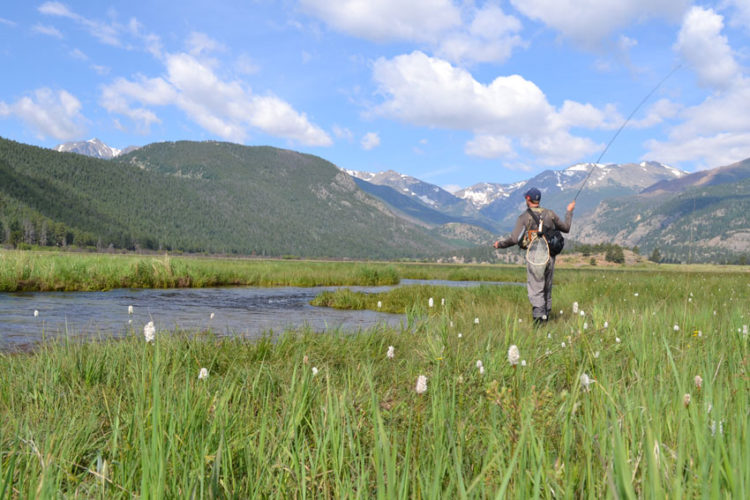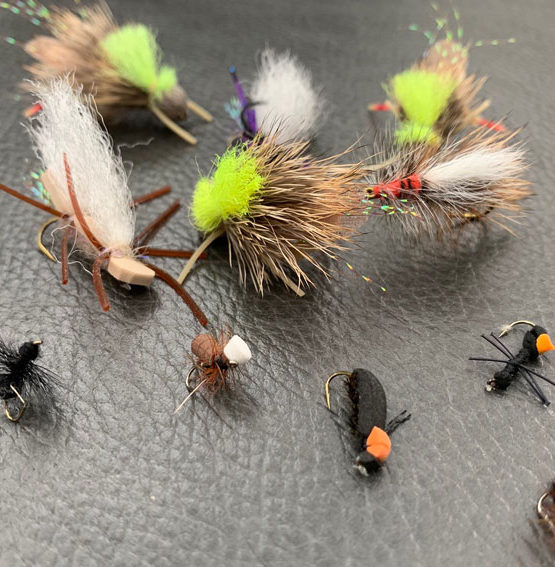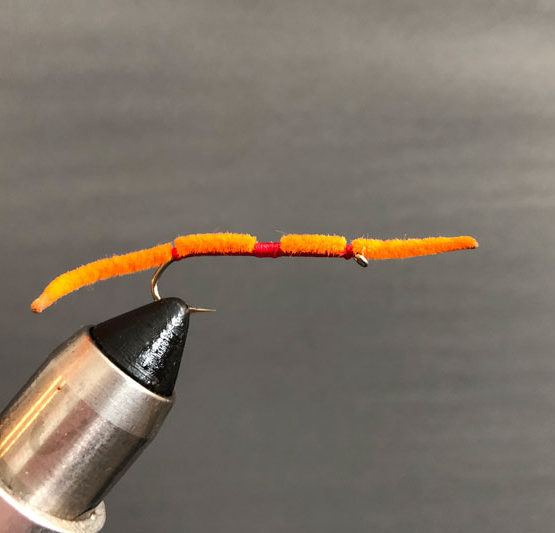Fly fishing small streams and creeks can make for some of the most fun days you’ll ever experience as an angler. Whether you are fishing a small, cascading mountain stream, or a slow, meandering creek, there is an abundance of fly fishing opportunities to be had.
Sure, you might not be casting to 25-inch rainbows, but who really cares when you’re catching upwards of 25 or 30 fish in a day?
I grew up fly fishing small streams and creeks, so honestly, I get a little nostalgic talking about it. But more importantly, after all my experience in this particular arena of fly fishing, there are a number of tips and tricks I have either been taught, stumbled into, or learned the hard way. And that’s why I’m writing this article.
What follows are 25 tips for fly fishing small streams and creeks.
May they lead you to great success and enjoyment.
Related Content:
- 10 Baetis Nymph Patterns You Need To Try
- How Much Should You Tip A Fishing Guide?
- How Often Should You Clean Your Fly Line?
- 25 Best Dry Flies For Colorado Fly Fishing
- What Is An Attractor Fly? (With 10 Examples)
- Fishing The Bighorn River In Montana: The Ultimate Guide
- Can You Fly Fish Anywhere?
Disclaimer: This post may contain affiliate links, meaning we will receive a small commission (at no cost to you) if you click through and make a purchase.
1. Be Quiet
There’s something so pure and peaceful about fly fishing on a small stream. Between the soft hum and creaking of the wind through the trees, and the bubbling ripples of the water, it’s almost a sin to make too much noise. And the fish you are trying to catch feel the same way.
If you want to catch fish in a small stream, you need to be as quiet as possible. And I’m not just talking about the volume of your voice, which should be no more than a whisper. You need to walk quietly as you approach the river, and wade gently through the water.
The less you disturb your surroundings, the more likely you are to get into some fish.
2. Approach From Down Stream
If you are new to fly fishing, it’s important for you to know that fish face upstream. So, if you want to avoid spooking them, you should always — I repeat, always — approach a hole or run from down stream. And, to build on the previous section, do it as quietly as possible.
3. Keep Moving
The one thing I have learned throughout my years of fishing small streams and creeks, is that you shouldn’t linger in one spot for too long.
Unlike fishing a large river where you can cast to the same spot over and over again, fish in small creeks are a little too skittish for that. And, they don’t tend to pod-up quite as much.
If you are lucky, you will catch 2 or 3 fish from one little run when.
4. Make A Great First Cast
I can’t stress this tip enough. When you are fishing a small stream or creek, you need to nail the first cast. Often times, this will be your only opportunity to catch the attention of a fish before it catches on to your trickery and decides to shun you.
The better you place, and the gentler you land, your very first cast in every hole, the more likely you are to hook a fish.
5. Use The High-Stick Method
The high-stick method is about as simple as it gets in fly fishing. You just limit the amount of line in your cast, stand fairly close to the pocket of water you are trying to fish, and keep your tip high throughout your drift.
Your goal with high-sticking is to keep your drift short, get in as many casts as possible, and keep your fly line off the water. The high-stick method reduces your chances of disturbing any feeding fish with the hard slap of a sloppy cast; which is why it is so effective.
6. Fish A Dry-Dropper Rig
I almost exclusively fish a dry-dropper rig when I am fly fishing on small streams or creeks. First of all, the water is usually shallow enough that a dropper will give you enough depth to get down to any feeding fish.
Second of all, you will be amazed how many little trout are willing to hit a dry fly that’s half their size.
Fishing a dry-dropper rig gives you the best of both worlds, and greatly increases your chance of a fish.
7. Look For Bubbles
When you are walking up the bank — or the middle — of a small stream, and you see some bubbles floating through a riffle, or foaming behind a boulder, throw a couple casts in there.
Fish tend to congregate in well-oxygenated water, so when you cast into any bubbles, you are probably casting into a little group of fish. Just be ready the moment your flies hit the water. Fish that are all jacked-up on oxygen are hyper, competitive, and at-the-ready. So, be quick on the hook-set.
8. Go The Distance
One of the best opportunities that small streams and creeks provide for anglers, is the ability to fish in solitude. And the further you are willing to hike, or drive, the smaller the crowds tend to get.
Now, this may not be true for every small stream, but in my experience, most anglers don’t have the patience to walk past a beautiful stretch of river, even if it means standing shoulder-to-shoulder with other fishermen.
So, if other fly fishermen are only willing to hike one mile, then be willing to hike two. If you need to go off-roading for an extra 30 minutes, then do it. Not only will you end up fishing in private, but you’ll be casting to fish that see significantly less pressure.
9. Cast Behind Structure In The River
Fish use structure in a river to protect themselves from predators, and to avoid having to fight the current all day long.
Therefore, if you see any kind of structure in the middle of a small stream, then don’t pass it by. Every single branch, boulder, culvert, bridge, or bush deserves at least a couple casts from you.
10. Don’t Neglect The Shallows
Fish in small streams tend to be a little smaller than fish in big rivers; which I’m guessing doesn’t bother you, since you are reading about fly fishing small streams. And since these fish are smaller, they don’t have any problem swimming in shallow water.
So, if you see a little section of shallow water, don’t neglect it like most other anglers would. There might be a whole slew of hungry fish in there just waiting to slam your fly.
11. Focus On Short Drifts
I made mention of short drifts when I talked about high-sticking, but it’s important enough to call out on its own. When you are fishing small creeks, there is no real reason to fish long drifts. Unless you stumble upon a slow, deep pool of water, stacked with fish, then you should try to keep your drifts shorter than usual.
Long drifts increase your risk of snags and tangles, which can put a major damper on your day. So, reel in that extra line. You don’t need it.
12. Don’t Get Distracted
Everything happens quickly on small streams. Your cast is quick, your drift is quick, and fish make quick-decisions.
The moment you take your eye off the ball, a fish will probably hit your fly, and you will miss the take. Ask just about any experienced angler, and they will back me up.
13. Pay Attention To Your Shadow
The angle of your shadow is extremely important in fly fishing. And the smaller the stream is that you are fishing, the more important it is to keep your shadow off the water you are fishing.
At times, that means you will have to cross the river before approaching a hole. And when that isn’t possible, you may need to crouch down and make your shadow as small as possible.
Fish equate moving shadows with danger, and will swim to safer areas if they feel threatened. So, pay attention to your shadow at all times.
14. Sein The Water
For a long time, to start a day of fishing, I would just pick up a rock off the bottom of a river, and try to match my flies to whatever I saw crawling around. The problem with this method, was that these little insects and annelids don’t give you a clear picture of what’s actually floating in the water.
That’s where a water sein is so valuable.
Just dip it in the water for a few seconds, pull it up, and you can see exactly what’s floating down the river at that moment. It’s a beautiful thing.
15. Change Your Fly Often
On small streams, fish can be a little finicky. One moment they are gorging on prince nymphs, and the next moment they won’t even sniff it. And, as an angler, if you stay too committed to one fly, you could miss out on all sorts of fish.
Don’t be lazy, or stuck in your ways. Be willing to change your rig often, and test new flies. You will catch more fish this way.
16. Use A Smaller Fly Rod
They make fly rods in different sizes for a reason. In other words, if you are fishing an eight weight — that was designed for catching steelhead — on a river as wide as your bathtub, then you might just rip the face off the next fish you catch.
If you are looking to fish more small streams and creeks, then ditch that rebar you’re using, and get yourself a 3 or 4-weight rod.
17. Be Gentle When You Set The Hook
One thing I know about tuna, is that they don’t live in small streams, so don’t set the hook on a 6-inch trout, like you would on a 1,000 pound Bluefin.
I can tell you from personal experience that if you slam a take on a small stream trout, you will probably end up sending the poor little thing hurtling through the air at about Mach 4. And trust me, fish don’t like that.
On small streams, your hook set should be no more than a flick of the wrist.
18. Crimp Your Barbs
If you’ve ever tried to pull a size 14 stimulator out of a 5” trout, you probably understand why you should crimp the barbs on your hooks. Small stream fish are beautiful, innocent, over-eager little rascals that like to show off and hit flies that are half their size.
If you don’t crimp your barbs, not only are you likely to kill the fish, but you will have a heck of a time getting your fly out of their mouth.
Sure, a few fish might drop you off, but that’s better than using forceps to tear your fly, and the mandible off of a tender, baby fish’s mouth.
“Wow, that escalated quickly… I mean, that really got out of hand!” — Ron Burgundy
Then again, if you are planning to keep a couple fish — because small stream trout make for great eatin’ — then disregard this little tip.
19. Blend In (Don’t Wear Bright Colors)
Fly fishing small streams and creeks is all about stealth. And I don’t know about you, but I’ve never seen a ninja walking around in a bright orange jumpsuit.
I’m not saying you need to go out and purchase a bunch of camo, or wear a ghillie suit while you fly fish. I’m just saying that you should opt for earth tones over bright, or white clothing.
20. Hide
Small streams offer a lot of opportunities to cast from hidden locations. If you can crouch behind a bush on the riverside, or cast from behind a boulder in the middle of a river, you are much less likely to spook any fish.
Take advantage of natural obstructions as often as you possibly can. It will result in success.
21. Get Your Flies Down Quick
Between your shorter drifts, smaller pockets of water, and rapid-fire casting, there isn’t much time for your flies to sink. But whether you are exclusively nymphing, or you are fishing a dry-dropper rig, you need to get your nymphs down fast.
Otherwise, your flies could be floating right over the heads of fish feeding near the bottom.
So, how do you get your flies to sink faster? Well, it’s easy. If you are fishing a single or double nymph rig, just add a couple split-shot weights to your line. And, if you are fishing a dry-dropper rig, try to use beadhead nymphs as often as possible.
22. Use Smaller Tippet
To the human eye, the difference between the varying sizes of tippet might not seem significant. But, to a small mountain stream trout, there is a stark difference. So, if you want to catch them, you need to use the smallest tippet you have.
In general, you should plan to fish with 6X or even 7X if you want to maximize your success. On top of that, I recommend using fluorocarbon tippet. It is a little more expensive than regular monofilament, but it is much less visible in water.
23. Fish Without An Indicator
If you do decide to go with a nymph-only rig, then you might want to forego your strike indicator. When you are high-sticking, and focusing on shorter drifts, your strike indicator doesn’t serve that much of a purpose anyway.
So, you might as well just take it off, and fish like our forefathers used to — indicator-less.
24. Get Creative With Your Casting
Casting can get a little tight when you are fly fishing a small stream. In fact, at times, you won’t even have any room for a back cast. So, you will need to figure out a different method for getting your flies into the feeding zone.
At minimum, you should get good at a roll cast, but if you want to get really advanced, you could try the bow and arrow cast. These are both great techniques for getting your fly into tight spaces, and they reduce your risk of snags and tangles.
25. Add some Life To Your Fly
When you are dry fly fishing a slower moving pool, and fish just don’t seem at all interested, don’t be afraid to add a little life to your fly. Sometimes, a couple little twitches is all it takes to trick a fish into thinking your fly is the real deal.
Final Thoughts
Small streams and creeks can make for some of the most fun fly fishing you can find. Between the volume of fish you can catch, the variety in landscape, and the unique fishing techniques can employ, there’s never a dull moment.
So, pick up your fly rod, and get out there. A small stream is probably calling your name.
If you liked this article, be sure to join our community of anglers by subscribing to our email list! And remember, for the days you can’t spend on the water, this is your Fly Fishing Fix.
Join Fly Fishing Fix, Today!










